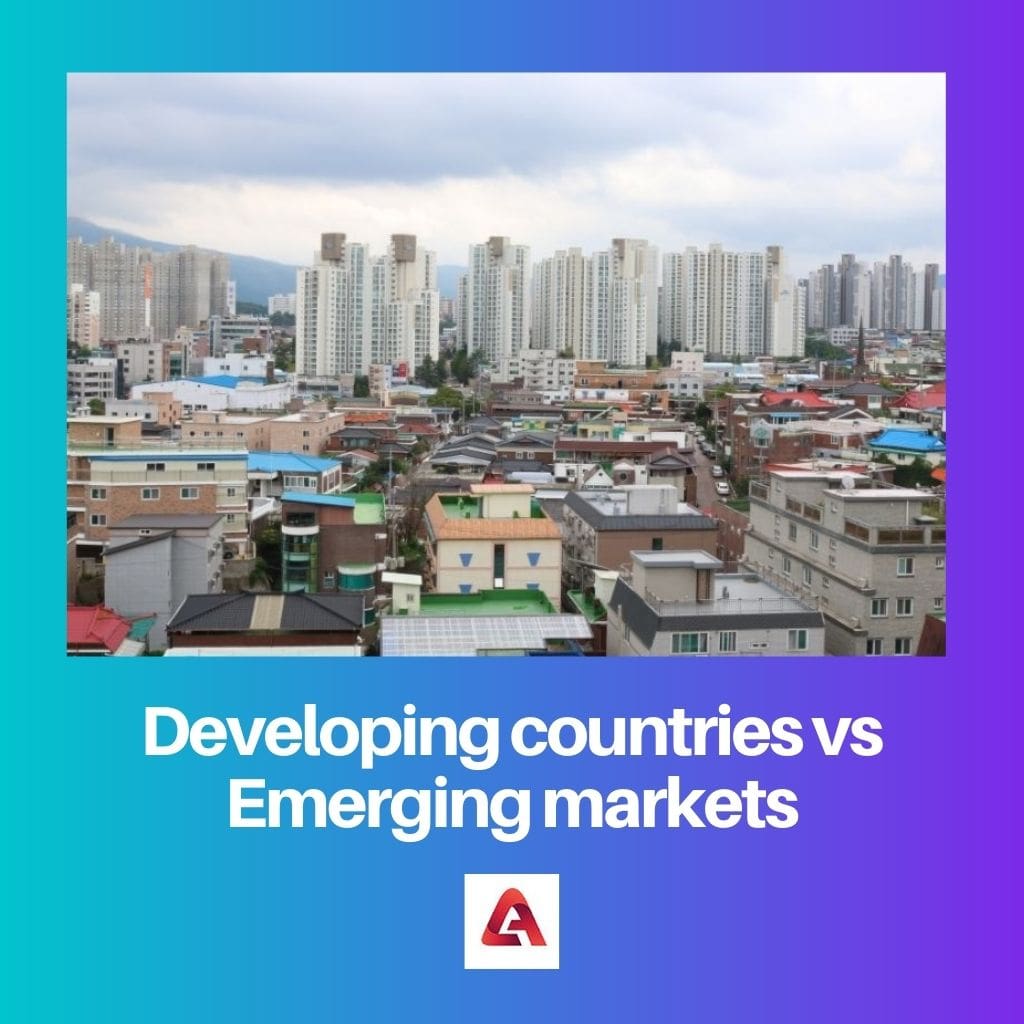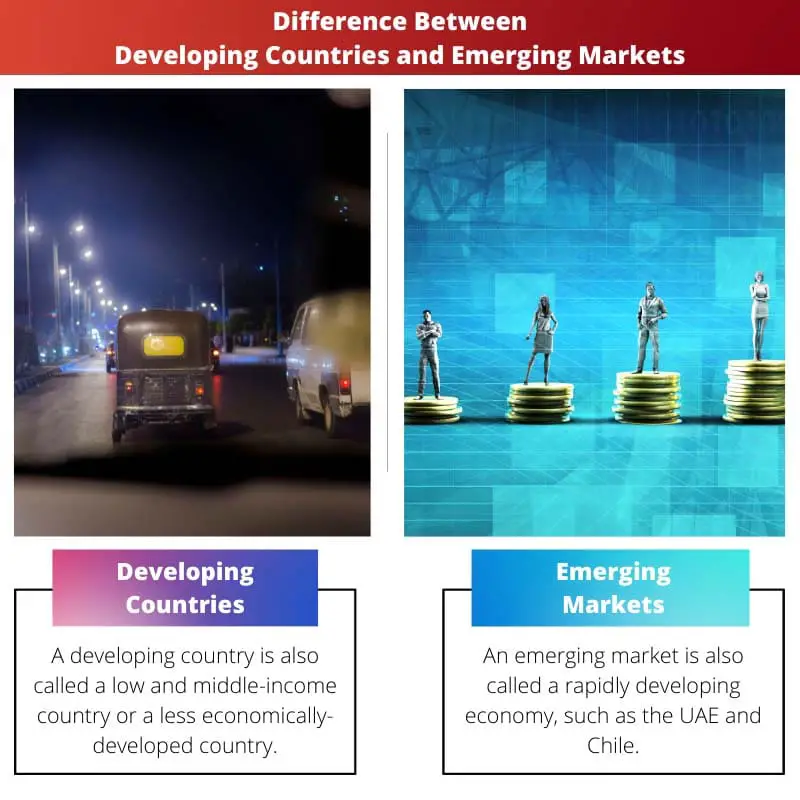Developing countries typically refer to nations with lower income levels, often characterized by inadequate infrastructure and basic services. Emerging markets, on the other hand, denote countries with rapidly growing economies, transitioning towards industrialization and modernization, often offering investment opportunities with potential for high returns amidst some degree of volatility and risk.
Key Takeaways
- Developing countries have lower income levels, industrialization, and human development; emerging markets are nations experiencing rapid growth and increasing global economic integration.
- Developing countries can include nations with various economic statuses; emerging markets demonstrate strong growth potential and investment opportunities.
- Developing countries may face various challenges, from infrastructure to education; emerging markets attract foreign investment and experience economic liberalization.
Developing Countries vs Emerging Markets
The difference between Developing Countries and Emerging Markets is that while developing countries have weak trading ties due to being primarily engaged in agriculture and indigenous industries, emerging markets have undergone high economic development owing to industrialization.

Comparison Table
| Feature | Developing Countries | Emerging Markets |
|---|---|---|
| Economic Status | Lower income and standard of living compared to developed countries. | Economies transitioning from developing to developed status, with lower income than developed nations but higher than least developed countries. |
| Human Development Index (HDI) | Generally lower HDI scores. | Varied HDI scores, but generally lower than developed countries and higher than least developed countries. |
| Industrialization | Varied levels of industrial development, but generally less industrialized than developed countries. | Growing industrial and manufacturing sectors, but may still rely heavily on agriculture or resources. |
| Infrastructure | Less developed infrastructure, including transportation, communication, and sanitation systems. | Developing infrastructure, with improvements needed but offering a base for economic growth. |
| Investment | Lower levels of foreign and domestic investment. | Increasing levels of foreign and domestic investment due to perceived growth potential. |
| Growth Potential | Varied, but generally slower and more focused on basic needs. | Higher potential for rapid economic growth due to a growing workforce, resource wealth, and increasing industrialization. |
| Market Characteristics | Less developed financial markets and stock exchanges. | Developing financial markets with increasing participation in global trade. |
| Political Stability | Political stability can vary widely. | Political stability can vary, but emerging markets often face challenges in governance and corruption. |
| Examples | China (developing towards an emerging market), India, Brazil, Thailand | China (considered an emerging market by some), Brazil, India, South Africa |
What are Developing Countries?
Economic Characteristics
- Low GDP per Capita: Developing countries typically exhibit a lower Gross Domestic Product (GDP) per capita compared to developed nations. This signifies a lower average income level among the population.
- High Poverty Rates: Poverty is widespread in developing countries, with a significant portion of the population living below the poverty line. Limited access to education, healthcare, and employment opportunities perpetuate the cycle of poverty.
- Dependence on Agriculture: Many developing countries rely heavily on agriculture as a primary source of income and livelihood. However, agricultural practices are often subsistence-based and vulnerable to factors like climate change, leading to food insecurity and economic instability.
Social and Developmental Indicators
- Limited Access to Education: Educational opportunities in developing countries are often inadequate, with high dropout rates and low literacy levels. This lack of education hinders human capital development and limits economic advancement.
- Poor Healthcare Infrastructure: Healthcare systems in developing countries are typically underfunded and lack essential resources. This results in inadequate access to healthcare services, leading to preventable diseases and high mortality rates.
- Infrastructure Deficits: Infrastructure development, including roads, transportation networks, and utilities such as electricity and clean water, is often insufficient in developing countries. This impedes economic growth and hampers the delivery of essential services to the population.
Challenges and Opportunities
- Economic Vulnerability: Developing countries are susceptible to external shocks such as fluctuations in commodity prices, natural disasters, and global economic downturns. This vulnerability can exacerbate poverty and hinder long-term development efforts.
- Potential for Growth: Despite challenges, developing countries often possess untapped potential for economic growth and development. Strategic investments in infrastructure, education, healthcare, and technology can unlock opportunities for sustainable development and poverty reduction.
- International Assistance and Cooperation: International organizations, aid agencies, and developed nations often provide assistance and support to developing countries through financial aid, technical expertise, and capacity-building initiatives. Collaboration and cooperation are essential for addressing the complex challenges faced by developing nations and fostering inclusive growth and development.

What are Emerging Markets?
Economic Characteristics
- Dynamic Economic Growth: Emerging markets are characterized by robust economic growth rates that outpace those of developed nations. This growth is often driven by factors such as industrialization, urbanization, and increased domestic consumption.
- Structural Transformation: Emerging markets undergo structural changes in their economies, transitioning from agriculture-based to industry and service-oriented sectors. This transformation fuels productivity gains, job creation, and increased competitiveness on the global stage.
- Market Liberalization: Many emerging markets pursue policies of market liberalization, including deregulation, privatization, and trade liberalization, to attract foreign investment and stimulate economic growth. These reforms often contribute to greater efficiency and competitiveness in the economy.
Investment Potential
- High Return Potential: Emerging markets offer investors the opportunity for high returns on investment due to their rapid economic growth and expanding consumer markets. Investments in sectors such as technology, telecommunications, finance, and consumer goods are particularly attractive.
- Diversification Benefits: Investing in emerging markets can provide diversification benefits for portfolios, reducing overall investment risk by spreading exposure across different regions and asset classes. This diversification can help mitigate the impact of volatility in developed markets.
- Risk Factors: While emerging markets present attractive investment opportunities, they also entail higher levels of risk compared to developed markets. Factors such as political instability, currency volatility, regulatory uncertainty, and inadequate infrastructure can pose challenges for investors.
Opportunities and Challenges
- Demographic Dividend: Many emerging markets benefit from young and growing populations, which present opportunities for labor market expansion, increased consumer demand, and innovation-driven growth. Harnessing this demographic dividend requires investments in education, healthcare, and skills development.
- Infrastructure Development: Infrastructure development is a critical priority for emerging markets to sustain economic growth and improve living standards. Investments in transportation, energy, telecommunications, and urban infrastructure are essential for enhancing productivity and competitiveness.
- Integration into Global Economy: Emerging markets seek to integrate into the global economy through trade liberalization, foreign direct investment, and participation in international organizations and agreements. Greater integration offers opportunities for economic diversification, technology transfer, and knowledge sharing but also exposes countries to external shocks and vulnerabilities.

Main Differences Between Developing Countries and Emerging Markets
- Economic Status:
- Developing countries generally have lower GDP per capita compared to emerging markets.
- Emerging markets exhibit rapid economic growth and industrialization, while developing countries may struggle with stagnant economies and limited industrial development.
- Investment Potential:
- Emerging markets offer higher investment returns and opportunities due to their dynamic growth rates and expanding consumer markets.
- Developing countries may offer investment opportunities but often with higher levels of risk and lower returns compared to emerging markets.
- Infrastructure and Development:
- Emerging markets typically have better infrastructure and more advanced development compared to developing countries.
- Developing countries often face challenges related to inadequate infrastructure, limited access to education and healthcare, and lower levels of human development.
- Risk Profile:
- Emerging markets generally pose higher risks but also offer higher potential rewards for investors compared to developing countries.
- Developing countries may present more significant risks related to political instability, economic volatility, and social unrest, which can deter investment and hinder development efforts.
- Market Maturity:
- Emerging markets are in the process of transition towards becoming fully developed economies, experiencing rapid growth and structural transformation.
- Developing countries may have less diversified economies and rely heavily on traditional sectors such as agriculture, with slower rates of economic growth and industrialization.

- https://scholar.smu.edu/cgi/viewcontent.cgi?article=1935&context=til
- https://madoc.bib.uni-mannheim.de/915/1/dp0464.pdf

It’s not you get to see such clear and detailed articles about such complex topics. This has provided a great deal of clarity.
The detailed comparison between developing countries and emerging markets was presented exceptionally well.
I couldn’t agree more. The depth of understanding gained has been invaluable.
This article really helped me understand the differences between developing countries and emerging markets. I always thought they were the same, but now I see the distinctions clearly.
I agree, this article was very informative and well-written.
I found the information to be concise and well-structured, very helpful indeed.
I’m surprised by how much I didn’t know about the nuances between developing countries and emerging markets. This has widened my perspective immensely.
It’s not always easy to find comprehensive sources on this topic, so I’m thankful for this article.
The accuracy and depth of information in this article have been beneficial. My knowledge base on this subject has expanded considerably.
Exactly, the value derived from this information goes beyond what I had expected.
The article’s content was indeed presented in an excellent manner, providing a comprehensive understanding of the subject.
This information has given me a higher level of understanding about global economies. It’s refreshing to gain new insights in such a clear manner.
Absolutely, this article was a great support in improving my knowledge about economic classifications.
The depth and precision of the information provided in this article have made it a valuable resource for further study.
I found the breakdown of the differences in trading ties and economic development very enlightening. This article has certainly broadened my knowledge.
The clarity of the comparison table was particularly helpful in understanding the distinctions between developing countries and emerging markets.
This article illustrated some aspects I hadn’t considered before, and I’m glad to have gained new insights.
The vast amount of information presented here is exactly what I needed to better comprehend issues in global economics. An excellent piece.
Agreed, and the clear distinctions made in the article have greatly enhanced my understanding.
The comprehensive nature of this article, covering both the definitions and comparison table, made it an interesting read.
I particularly appreciated the well-organized format and the clarity administered by this piece.
I found the explanations of developing countries and emerging markets to be both intellectually stimulating and highly educational.
It’s refreshing to find such well-researched and insightful articles on economic classifications.
I couldn’t agree more. The article expounded on complex topics very clearly.
The differentiation between the two terms is crucial and overlooked. It’s great to have all this in-depth information in one place.
Absolutely, having a clear understanding of how developing countries and emerging markets differ is important for global economic strategies.